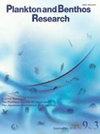将外共生鳞虫Asterophilia culcitae(环节动物:多角虫科)的寄主范围扩大到棘皮动物的三个纲,并对其体色变化进行了研究
IF 0.9
4区 生物学
Q4 MARINE & FRESHWATER BIOLOGY
引用次数: 4
摘要
:由于背表面有鳞片状的鞘翅,通常被称为“介壳虫”,其中包含许多与其他无脊椎动物共生的物种。这些共生体大多是宿主特有的,但也有一些宿主种类繁多。Asteophilia属包括两个物种,它们生活在太平洋的亚热带至热带浅水区,是小行星的外共生体,更罕见的是,是海百合。在这里,我们记录了来自小行星宿主(Culcita novaeguineae、Linkia laevigata、L.guidingi和Leiaster leachi)的菊科Astrophilia culcitae,并首次记录了来自温暖的日本太平洋海岸的全苏生宿主(Stichopus chloronotus、Holothuria atra、H。苏云金藻标本的细胞色素c氧化酶亚基I序列与小行星宿主的细胞色素c氧化酶亚基序列没有显著差异,这证明了A.culcitae在三个不同的棘皮动物类别中具有广泛的宿主范围:小行星、苏云金虫和海百合。尽管先前的一项研究表明,无论宿主的体色如何,菊芋的总体体色都是红色(雌性)或白色(雄性)。然而,我们发现,一个来自海龙宿主的个体表现出不同的颜色模式:a.culcitae通常表现出三个白色或黄色的鞘翅丘,这些丘被认为是模仿小行星宿主的管脚,而一个来自chloronotus的个体则有红棕色的半透明丘,我们认为这可能在其海龙宿主上是神秘的。本文章由计算机程序翻译,如有差异,请以英文原文为准。
Widening the host range of the ectosymbiotic scale-worm Asterophilia culcitae (Annelida: Polynoidae) to three echinoderm classes, with data on its body color variation
: The Polynoidae, commonly known as “scale-worms” due to the scale-like elytra on the dorsal surface, contains many species living in symbioses with other invertebrates. Most of these symbionts are host-specific, but some have a wide range of hosts. The genus Asterophilia includes two species living in shallow subtropical to tropical waters in the Pacific Ocean as ectosymbionts of asteroids and, more rarely, crinoids. Here, we recorded Asterophilia culcitae from asteroid hosts ( Culcita novaeguineae , Linckia laevigata , L. guildingi , and Leiaster leachi ) and, for the first time, from holothurian hosts [ Stichopus chloronotus , Holothuria atra , H. ( Stauropora ) pervicax , and Bohadschia argus ] along warm Japanese Pacific coasts. The cytochrome c oxidase subunit I sequences of the specimens from holothurians did not differ significantly from those on asteroid hosts, proving that A. culcitae has a wide host range across three dif-ferent echinoderm classes: asteroids, holothurians, and crinoids. The general body color of A. culcitae was constantly reddish (female) or whitish (male), regardless of the host body color, although a previous study suggested that it differs in accordance with the host body color. However, we found that one individual from a holothurian host showed a dif-ferent color pattern: A. culcitae typically shows three whitish or yellowish elytral mounds that have been suggested to mimic the tube foot of the asteroid hosts, whereas one individual from S. chloronotus had reddish brown translucent mounds, which we suggest might be cryptic on its holothurian host.
求助全文
通过发布文献求助,成功后即可免费获取论文全文。
去求助
来源期刊

Plankton & Benthos Research
Agricultural and Biological Sciences-Aquatic Science
CiteScore
1.30
自引率
0.00%
发文量
32
期刊介绍:
Plankton and Benthos Research is a peer-reviewed journal publishing quarterly original papers, reviews and notes dealing with any aspect of the biology and ecology of planktonic and benthic organisms and their interactions with the environment in any aquatic system, and is open to all scientists around the world. Submission of a paper is held to imply that it represents an original contribution not previously published and that it is not being considered elsewhere.
 求助内容:
求助内容: 应助结果提醒方式:
应助结果提醒方式:


